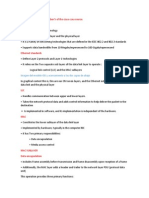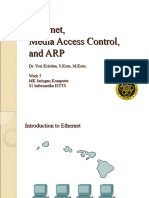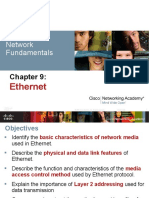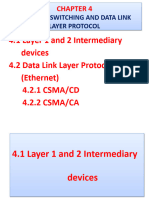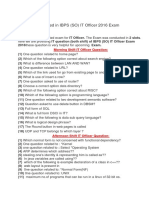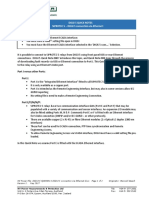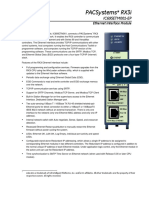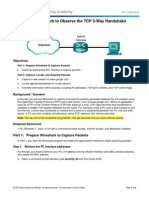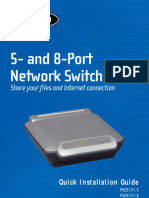Chapter 5:
Ethernet
Introduction to Networks
�Chapter 5: Objectives
Upon completion of this chapter, you will be able to:
Describe the operation of the Ethernet sublayers.
Identify the major fields of the Ethernet frame.
Describe the purpose and characteristics of the Ethernet MAC
address.
Describe the purpose of ARP.
Explain how ARP requests impact network and host
performance.
Explain basic switching concepts.
Compare fixed configuration and modular switches.
Configure a Layer 3 switch.
�Chapter 5
5.0
5.1
5.2
5.3
5.4
Introduction
Ethernet Protocol
Address Resolution Protocol
LAN Switches
Summary
�5.1 Ethernet Protocol
�Ethernet Operation
LLC and MAC Sublayers
Ethernet
One of the most widely used LAN
technologies
Operates in the data link layer and the
physical layer
Family of networking technologies that
are defined in the IEEE 802.2 and 802.3
standards
Supports data bandwidths of 10, 100,
1000, 10,000, 40,000, and 100,000 Mbps
(100 Gbps)
Ethernet Standards
�Ethernet Operation
LLC and MAC Sublayers (cont.)
�Ethernet Operation
LLC and MAC Sublayers (cont.)
LLC
Handles communication between upper and lower layers.
Takes the network protocol data and adds control information
to help deliver the packet to the destination.
MAC
Constitutes the lower sublayer of the data link layer.
Implemented by hardware, typically in the computer NIC.
Two primary responsibilities:
Data encapsulation
Media access control
�Ethernet Operation
MAC Sublayer
�Ethernet Operation
MAC Sublayer (cont.)
Data encapsulation
Frame assembly before transmission and frame disassembly
upon reception of a frame.
MAC layer adds a header and trailer to the network layer
PDU.
Provides three primary functions:
Frame delimiting Identifies a group of bits that make up a
frame, synchronization between the transmitting and
receiving nodes.
Addressing Each Ethernet header added in the frame
contains the physical address (MAC address) that enables a
frame to be delivered to a destination node.
Error detection Each Ethernet frame contains a trailer
with a cyclic redundancy check (CRC) of the frame contents.
�Ethernet Operation
MAC Sublayer (cont.)
MAC
Responsible for the placement of frames on the media and the
removal of frames from the media
Communicates directly with the physical layer
If multiple devices on a single medium attempt to forward data
simultaneously, the data will collide resulting in corrupted,
unusable data
Ethernet provides a method for controlling how the nodes
share access through the use a Carrier Sense Multiple Access
(CSMA) technology
�Ethernet Operation
Media Access Control
Carrier Sense Multiple Access
(CSMA) process
Used to first detect if the media is carrying a signal
If no carrier signal is detected, the device transmits its data
If two devices transmit at the same time - data collision
�Ethernet Operation
Media Access Control (cont.)
�Ethernet Operation
Media Access Control (cont.)
CSMA is usually implemented in conjunction with a method for
resolving media contention. The two commonly used methods
are: CSMA/Collision Detection and CSMA/Collision
Avoidance
CSMA/Collision Detection
The device monitors the media for the presence of a data
signal
If a data signal is absent, indicating that the media is free,
the device transmits the data
If signals are then detected that show another device was
transmitting at the same time, all devices stop sending & try
again later
While Ethernet networks are designed with CSMA/CD
technology, with todays intermediate devices, collisions do
not occur and the processes utilized by CSMA/CD are really
unnecessary
�Ethernet Operation
Media Access Control (cont.)
CSMA/Collision Avoidance (CSMA/CA) media access
method
Device examines the media for the presence of data signal if the media is free, the device sends a notification across
the media of its intent to use it
The device then sends the data.
Used by 802.11 wireless networking technologies
�Ethernet Operation
MAC Address: Ethernet Identity
Layer 2 Ethernet MAC
address is a 48-bit binary
value expressed as 12
hexadecimal digits.
IEEE requires a vendor to
follow these rules:
Must use that
vendor's assigned
OUI as the first 3
bytes.
All MAC addresses
with the same OUI
must be assigned a
unique value in the
last 3 bytes.
�Ethernet Operation
Frame Processing
MAC addresses assigned to workstations, servers, printers,
switches, and routers.
Example MACs:
00-05-9A-3C-78-00
00:05:9A:3C:78:00
0005.9A3C.7800.
When a device is forwarding a message to an Ethernet
network, attaches header information to the packet, contains
the source and destination MAC address.
Each NIC views information to see if the destination MAC
address in the frame matches the devices physical MAC
address stored in RAM.
No match, the device discards the frame.
Matches the destination MAC of the frame, the NIC passes the
frame up the OSI layers, where the de-encapsulation process
takes place.
�Ethernet Frame Attributes
Ethernet Encapsulation
Early versions of
Ethernet were slow
at 10 Mb/s.
Now operate at 10
Gb/s per second and
faster.
Ethernet frame
structure adds
headers and trailers
around the Layer 3
PDU to encapsulate
the message being
sent.
Ethernet II is the
Ethernet frame format
used in TCP/IP
networks.
Comparison of 802.3 and Ethernet II Frame Structures and Field Size
�Ethernet Frame Attributes
Ethernet Frame Size
Ethernet II and IEEE 802.3 standards define the minimum
frame size as 64 bytes and the maximum as 1518 bytes
Less than 64 bytes in length is considered a "collision
fragment" or "runt frame
If size of a transmitted frame is less than the minimum or
greater than the maximum, the receiving device drops the
frame
At the physical layer, different versions of Ethernet vary in
their method for detecting and placing data on the media
�Ethernet Frame Attributes
Ethernet Frame Size (cont.)
The figure displays the fields contained in the 802.1Q VLAN tag
�Ethernet Frame Attributes
Introduction to the Ethernet Frame
Preamble and Start
Frame Delimiter
Fields
Used for
synchronization
between the sending
and receiving
devices.
Length/Type Field
Defines the exact
length of the frame's
data field; describes
which protocol is
implemented.
Data and Pad
Fields
Contains the
encapsulated
data from a
higher layer, an
IPv4 packet.
�Ethernet Frame Attributes
Introduction to the Ethernet Frame
(cont.)
Frame Check Sequence Field
Used to detect errors in a frame with cyclic redundancy check (4
bytes); if calculations match at source and receiver, no error
occurred.
�Ethernet MAC
MAC Addresses and
Hexadecimal
�Ethernet MAC
MAC Address Representations
�Ethernet MAC
Unicast MAC Address
�Ethernet MAC
Broadcast MAC Address
�Ethernet MAC
Multicast MAC Address
Multicast MAC address is a
special value that begins with
01-00-5E in hexadecimal
Range of IPV4 multicast
addresses is 224.0.0.0 to
239.255.255.255
�MAC and IP
MAC and IP
MAC Address
This address does not change
Similar to the name of a person
Known as physical address because physically assigned to
the host NIC
IP Address
Similar to the address of a person
Based on where the host is actually located
Known as a logical address because assigned logically
Assigned to each host by a network administrator
Both the physical MAC and logical IP addresses are required for a
computer to communicate just like both the name and address of a
person are required to send a letter.
�Ethernet MAC
End-to-End Connectivity, MAC,
and IP
IP Packet Encapsulated in an Ethernet Frame
�Ethernet MAC
End-to-End Connectivity, MAC, and IP (cont.)
�5.2 Address Resolution
Protocol
�ARP
Introduction to ARP
ARP Purpose
Sending node needs a way to find the MAC address of the
destination for a given Ethernet link
The ARP protocol provides two basic functions:
Resolving IPv4 addresses to MAC addresses
Maintaining a table of mappings
�ARP
Introduction to ARP (cont.)
�ARP
ARP Functions/Operation
ARP Table
Used to find the data link layer address that is mapped to the
destination IPv4 address.
As a node receives frames from the media, it records the
source IP and MAC address as a mapping in the ARP table.
ARP Request
Layer 2 broadcast to all devices on the Ethernet LAN.
The node that matches the IP address in the broadcast will
reply.
If no device responds to the ARP request, the packet is dropped
because a frame cannot be created.
Note: Static map entries can be entered in an ARP table, but this is
rarely done.
�ARP
ARP Operation
�ARP
ARP Operation (cont.)
�ARP
ARP Operation (cont.)
�ARP
ARP Operation (cont.)
�ARP
ARP Functions/Operation
(cont.)
�ARP
ARP Role in Remote
Communication
If the destination IPv4 host is on the local network, the frame will use
the MAC address of this device as the destination MAC address.
If the destination IPv4 host is not on the local network, the source
uses the ARP process to determine a MAC address for the router
interface serving as the gateway.
In the event that the gateway entry is not in the table, an ARP
request is used to retrieve the MAC address associated with the IP
address of the router interface.
�ARP
Removing Entries from an ARP
Table
The ARP cache
timer removes
ARP entries
that have not
been used for a
specified
period of time.
Commands
may also be
used to
manually
remove all or
some of the
entries in the
ARP table.
�ARP
ARP Tables on Networking
Devices
�ARP Issues
How ARP Can Create Problems
�ARP Issues
Mitigating ARP Problems
�5.3 LAN Switches
�Switching
Switch Port Fundamentals
Layer 2 LAN Switch
Connects end devices to a central intermediate device on most
Ethernet networks
Performs switching and filtering based only on the MAC address
Builds a MAC address table that it uses to make forwarding
decisions
Depends on routers to pass data between IP subnetworks
�Switching
Switch MAC Address Table
1. The switch receives a broadcast frame from PC 1 on Port 1.
2. The switch enters the source MAC address and the switch port that
received the frame into the address table.
3. Because the destination address is a broadcast, the switch floods the
frame to all ports, except the port on which it received the frame.
4. The destination device replies to the broadcast with a unicast frame
addressed to PC 1.
�Switching
Switch MAC Address Table (cont.)
5. The switch enters the source MAC address of PC 2 and the port
number of the switch port that received the frame into the address
table. The destination address of the frame and its associated port is
found in the MAC address table.
6. The switch can now forward frames between source and destination
devices without flooding, because it has entries in the address table
that identify the associated ports.
�Switching
Duplex Settings
�Switching
Auto-MDIX
�Switching
Frame Forwarding Methods on Cisco Switches
�Switching
Cut-through Switching
Fast-forward switching:
Lowest level of latency
immediately forwards a
packet after reading the
destination address,
typical cut-through
method of switching
Fragment-free switching:
Switch stores the first
64 bytes of the frame
before forwarding, most
network errors and
collisions occur during
the first 64 bytes
�Switching
Memory Buffering on Switches
�Fixed or Modular
Fixed versus Modular
Configuration
�Fixed or Modular
Fixed versus Modular
Configuration (cont.)
�Fixed or Modular
Module Options for Cisco Switch
Slots
�Layer 3 Switching
Layer 2 versus Layer 3
Switching
�Layer 3 Switching
Cisco Express Forwarding
Cisco devices which support Layer 3 switching utilize Cisco Express
Forwarding (CEF). Two main components of CEF operation are the:
Forwarding Information Base (FIB)
Conceptually it is similar to a routing table.
A networking device uses this lookup table to make destinationbased switching decisions during Cisco Express Forwarding
operation.
Updated when changes occur in the network and contains all
routes known at the time.
Adjacency Tables
Maintain layer 2 next-hop addresses for all FIB entries.
�Layer 3 Switching
Types of Layer 3 Interfaces
The major types of Layer 3 interfaces are:
Switch Virtual Interface (SVI) Logical interface on a
switch associated with a virtual local-area network (VLAN).
Routed Port Physical port on a Layer 3 switch configured
to act as a router port. Configure routed ports by putting
the interface into Layer 3 mode with theno switchport
interface configuration command.
Layer 3 EtherChannel Logical interface on a Cisco
device associated with abundleof routed ports.
�Layer 3 Switching
Configuring a Routed Port on a Layer 3 Switch
�Chapter 5
Summary
Ethernet is the most widely used LAN technology used today.
Ethernet standards define both the Layer 2 protocols and the
Layer 1 technologies.
The Ethernet frame structure adds headers and trailers
around the Layer 3 PDU to encapsulate the message being
sent.
As an implementation of the IEEE 802.2/3 standards, the
Ethernet frame provides MAC addressing and error checking.
Replacing hubs with switches in the local network has
reduced the probability of frame collisions in half-duplex
links.
The Layer 2 addressing provided by Ethernet supports
unicast, multicast, and broadcast communications.
Ethernet uses the Address Resolution Protocol to determine
the MAC addresses of destinations and map them against
known Network layer addresses.
�Chapter 5
Summary (cont.)
Each node on an IP network has both a MAC address and an
IP address.
The ARP protocol resolves IPv4 addresses to MAC addresses
and maintains a table of mappings.
A Layer 2 switch builds a MAC address table that it uses to
make forwarding decisions.
Layer 3 switches are also capable of performing Layer 3
routing functions, reducing the need for dedicated routers on
a LAN.
Layer 3 switches have specialized switching hardware so
they can typically route data as quickly as they can switch.


